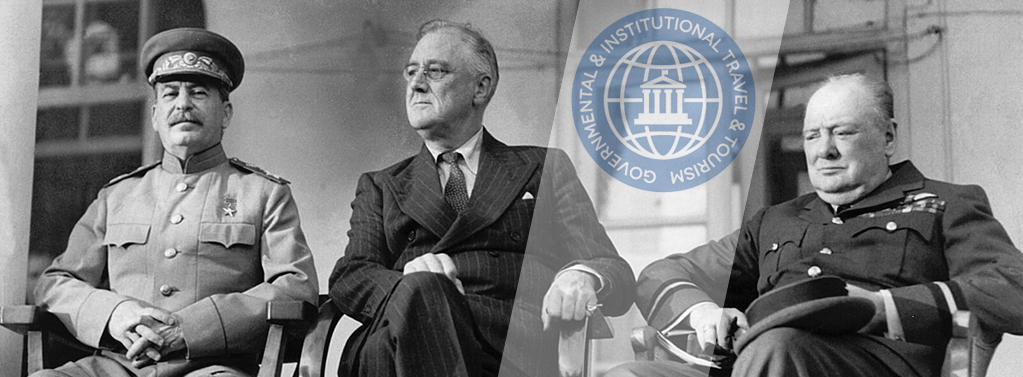
Many episodes in the history of mankind, and unfortunately, although increasingly isolated, in our present, have been marked by war. These dark events, which pit two or more factions against each other using force and weapons, paralyze almost all daily activities. However, despite the escalation of war, there is usually a continuous effort, or willingness, on the part of both sides, as well as third parties, to settle the conflict as soon as possible.
These efforts are translated into meetings whose main purpose is to negotiate peace. These meetings bring together the main leaders and representatives involved, which entails the displacement, in times of war, of prime ministers, heads of state, high-ranking military personnel, diplomats, advisors, experts, etc., with the consequent deployment in terms of security, protocol, accommodation and media coverage that this entails.
Although they were more frequent throughout the 20th century, it is considered that these trips as we know them today, arose as a result of the Congress of Vienna in 1814, in the twilight of the Napoleonic wars, which took place in the Ballhausplatz Palace in the Austrian capital. It was here that representatives of the main contenders and those involved met. Although the conflict was not yet over, the final defeat of Napoleon Bonaparte was assumed to be near, so the main objective of the Congress was to shape the European political scene after the end of the conflict. It is extremely important because, although it took place while the war was still active, it took place without incident, and was attended by delegations of all kinds, from governmental and institutional, to pressure groups, religious representatives and a long etcetera.
A good example of this type of governmental trips in times of war, carried out in neutral territories and with the purpose of reaching common points and reaching peace agreements, can be found in the Conference of Algeciras (Spain) in 1906. This meeting took place with the intention of resolving the diplomatic and military crisis that was taking place in Morocco and whose main actors were France and Germany. In addition, the summit was attended by third parties such as Spain, the United Kingdom, the United States and Russia, which ultimately contributed to the peaceful resolution of the conflict.
The 20th century was extremely turbulent by all accounts, and both the two world wars and the Cold War brought with them a large number of governmental movements aimed at resolving the conflicts that had been taking place. The first of these major meetings took place in Versailles (France) in 1919, after the end of the Great War - also known as the First World War. Although it is true that when delegations from practically all the countries of the world met in Versailles the war had already ended, Europe was still suffering the disasters of the conflict, with a very delicate economic situation, social upheaval and, in addition, the handicap that the world was still in the grip of the H1N1 pandemic -misnamed Spanish Flu-. This meant that, in besides all the protocol measures common to this type of events, important security measures were added, since the main objective of this summit was to restore the European and North African scenario, with Germany, Austria or Turkey in the spotlight. Moreover, Russia as such no longer existed and was in the throes of a civil war that would later lead to the creation of the Soviet Union (USSR).
The interwar period passed, as its name suggests, almost without major conflicts, but between the Great Depression of 1929, the rise of totalitarianisms and an increase in the war industry around the world.
The outbreak of World War II in September 1939 marked one of the darkest episodes in the history of mankind. The number of countries involved, including all the superpowers of the time, the high number of victims, both military and civilian, the Holocaust, the material and economic destruction of all of Europe and part of Asia, etc. were deliberate actions that until then had not occurred in any conflict on record.
The duration of the war also led to the creation of two main sides during this period: the so-called Allies and the Axis. The former included the United Kingdom, France and the United States, among many others. In the second, Germany, Italy and Japan, also with many other countries. In third place was the USSR, which was aligned with the Allies in their fight against the Germans and Italians in the East, and against the Japanese in the West. And, fourthly, there were other sides of lesser geopolitical significance - at the time - such as Nationalist China, Communist China or third countries that, in one way or another, intervened in the conflict, such as Switzerland, Spain, Argentina, etc.
The war brought with it three diplomatic meetings, at the highest level, which were fundamental in the course of the war, and which showed the commitment of the Allies and the Soviet Union to reestablish, in one way or another, the status quo in the world, and the end of the conflict:
- Casablanca Conference (Morocco), in January 1943. It took place at the iconic Anfa Hotel, and was attended by Franklin D. Roosevelt, President of the United States, Winston Churchill, British Prime Minister, and Charles de Gaulle, on behalf of the so-called Free France. Iósif Stalin of the USSR was also invited, but was unable to attend due to the bloody battle of Stalingrad that was taking place in Soviet territory. Despite being held in the middle of the war; the Casablanca Conference coordinated the actions of the Allies and the USSR in order to stop the conflict as soon as possible. Thus, it was decided to take joint action that would result in the immediate liberation of Italy by the Allies, a key factor that considerably reduced the duration of the war. In terms of security, it was particularly important, since it took place in Morocco, until recently in the hands of Vichy France and the Germans, with the movement of all their representatives by air, despite the European skies being dominated by the German Luftwaffe.
- Conference of Teheran (Persia), in November 1943. This was one of the most iconic conferences of World War II, attended by Iósif Stalin on behalf of the USSR, Winston Churchill of the United Kingdom and Franklin D. Roosevelt representing the United States. Being held in a neutral territory, close to the USSR, it was a summit full of pomp and protocol, in which during the gala dinner Churchill presented Stalin with a ceremonial sword at the request of King George VI in commemoration of the Soviet victory at Stalingrad. With the defeat of the Axis ever closer, it coordinated the so-called pincer that the Allies and the USSR intended to carry out on Germany from all the cardinal points. It was such an important event that, thanks to its famous photograph, its protagonists were popularly known as the "Big Three", due to the military and economic power that, at that time, the United States, the USSR and the United Kingdom had.
- Yalta Conference (USSR), February 1945. Victory for the Allies and the USSR was getting closer and closer. The German radius of action was already reduced to a minimum and capitulation was imminent. In a completely liberated Soviet Union, it was held in the Livadia Palace, and the security conditions were much more relaxed than on other occasions, due to the positive progress of the war. It is perhaps the most important meeting of the entire Second World War, in which the protocol was relegated to the background, being rather a summit oriented to very specific objectives: the redrawing of the European map after the German defeat and the creation of the future United Nations Organization (UN). It was the last conference of the "Big Three", as Franklin D. Roosevelt died prematurely at the age of 63 shortly afterwards.
- Potsdam Conference (Germany), July-August 1945. It takes place after the victory of the Allies and the USSR over the Axis, and with the defeat of Japan near. It was attended by Iósif Stalin for the USSR, Winston Churchill for the United Kingdom and Harry S. Truman for the United States. In Potsdam, the European map after the war was definitively configured, promoting the demilitarization and democratization of the territories previously occupied by the Germans. In the same way, the main parameters for judging German war criminals were also established, and during the war, in spite of the concord, protocol and cooperation, the differences between the capitalist bloc -the United States and the United Kingdom- and the communist bloc -the Soviet Union- began to emerge, this being one of the main triggers of the imminent Cold War.
During the rest of the 20th century and the beginning of the 21st century, thanks to the work of international organizations such as the UN and a redesign of geopolitics, conflicts became increasingly isolated and less intense. However, events such as the Cold War (1945-1991) led to a multitude of bilateral and multilateral summits between the United States, the USSR and its satellites, with the aim of avoiding military escalation and reducing tension between the two powers.
In fact, the fall of the USSR in 1991 did not mark the end of the struggle between the Western and Eastern powers. The rapid recovery of Russia, together with the meteoric economic, industrial and military rise of China, has led to the increasing frequency of such meetings, in which security and protocol, taken to the maximum expression, merge to give rise to meetings of the utmost importance at the international level. One of the most recent examples is the summit held between the United States and Russia in January 2022 in Geneva (Switzerland), in the midst of the COVID-19 pandemic, the aim of which was to reach certain agreements and reduce tension with regard to the Ukrainian crisis.





